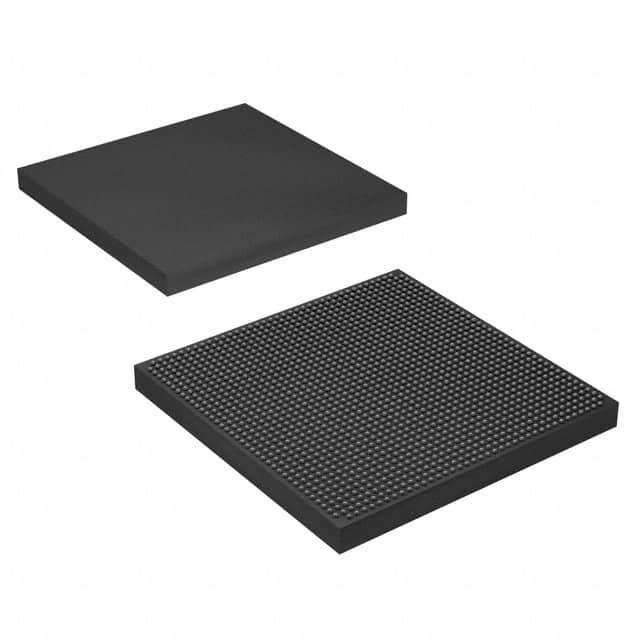Lihat spesifikasi untuk detail produk.

5SGXEA7N2F40I2N
Product Overview
Category
The 5SGXEA7N2F40I2N belongs to the category of Field-Programmable Gate Arrays (FPGAs).
Use
FPGAs are integrated circuits that can be programmed and reprogrammed to perform various digital functions. The 5SGXEA7N2F40I2N is specifically designed for high-performance applications that require complex logic and processing capabilities.
Characteristics
- High-performance FPGA with advanced features
- Large capacity and high-speed processing capabilities
- Flexible and reconfigurable design
- Low power consumption
- Robust and reliable performance
Package
The 5SGXEA7N2F40I2N comes in a compact and durable package, ensuring easy handling and protection during transportation and installation.
Essence
The essence of the 5SGXEA7N2F40I2N lies in its ability to provide a versatile and powerful platform for implementing complex digital designs and algorithms.
Packaging/Quantity
The 5SGXEA7N2F40I2N is typically packaged individually and is available in various quantities depending on the customer's requirements.
Specifications
- FPGA Family: Stratix V
- Logic Elements: 462,000
- Embedded Memory: 34,816 Kbits
- DSP Blocks: 1,288
- Maximum User I/Os: 1,040
- Operating Voltage: 1.0V
- Operating Temperature: -40°C to 100°C
- Package Type: F40
- Package Pins: 1517
Detailed Pin Configuration
The detailed pin configuration of the 5SGXEA7N2F40I2N can be found in the product datasheet provided by the manufacturer. It includes information on the pin names, functions, and electrical characteristics.
Functional Features
- High-speed processing: The 5SGXEA7N2F40I2N offers fast data processing capabilities, making it suitable for applications that require real-time performance.
- Reconfigurability: The FPGA can be reprogrammed to adapt to changing requirements or to implement different functionalities without the need for hardware changes.
- Versatility: With a large number of logic elements and embedded memory, the 5SGXEA7N2F40I2N can handle complex algorithms and designs.
- Low power consumption: The FPGA is designed to optimize power usage, making it energy-efficient and suitable for battery-powered devices.
Advantages and Disadvantages
Advantages
- High-performance capabilities
- Flexibility and reconfigurability
- Large capacity for complex designs
- Low power consumption
Disadvantages
- Higher cost compared to other programmable logic devices
- Steeper learning curve for programming and design implementation
Working Principles
The 5SGXEA7N2F40I2N operates based on the principles of digital logic. It consists of configurable logic blocks (CLBs), interconnects, and embedded memory elements. The CLBs can be programmed to implement various logic functions, while the interconnects provide the necessary connections between different components. The embedded memory elements allow for efficient storage and retrieval of data during operation.
Detailed Application Field Plans
The 5SGXEA7N2F40I2N finds applications in various fields, including:
- Telecommunications: Used in high-speed data transmission systems, network routers, and switches.
- Aerospace and Defense: Employed in radar systems, avionics, and military communication equipment.
- Industrial Automation: Utilized in control systems, robotics, and machine vision applications.
- Medical Devices: Integrated into medical imaging systems, patient monitoring devices, and diagnostic equipment.
- Automotive: Used in advanced driver assistance systems (ADAS), infotainment systems, and engine control units.
Detailed and Complete Alternative Models
- 5SGXEA7N2F40C2N
- 5SGXEA7N2F40I3N
- 5SGXEA7N2F40C3N
- 5SGXEA7N2F40I4N
- 5SGXEA7N2F40C4N
These alternative models offer similar features and capabilities to the 5SGXEA7N2F40I2N, with slight variations in specifications and package options.
Note: The content provided above is a sample and may not reflect actual product information.
Sebutkan 10 pertanyaan dan jawaban umum terkait penerapan 5SGXEA7N2F40I2N dalam solusi teknis
Sure! Here are 10 common questions and answers related to the application of 5SGXEA7N2F40I2N in technical solutions:
Q: What is the 5SGXEA7N2F40I2N FPGA used for? A: The 5SGXEA7N2F40I2N FPGA is a Field-Programmable Gate Array that can be used for various applications such as high-performance computing, networking, and signal processing.
Q: What are the key features of the 5SGXEA7N2F40I2N FPGA? A: Some key features of this FPGA include high logic density, high-speed transceivers, embedded memory blocks, and support for various I/O standards.
Q: Can the 5SGXEA7N2F40I2N FPGA be used for real-time video processing? A: Yes, the FPGA's high logic density and powerful processing capabilities make it suitable for real-time video processing applications.
Q: Does the 5SGXEA7N2F40I2N FPGA support high-speed data transfer? A: Yes, this FPGA has high-speed transceivers that support protocols like PCIe, Ethernet, and USB, enabling high-speed data transfer.
Q: Can the 5SGXEA7N2F40I2N FPGA be used for implementing complex algorithms? A: Absolutely, the FPGA's programmability allows for the implementation of complex algorithms, making it suitable for applications like cryptography or machine learning.
Q: Is the 5SGXEA7N2F40I2N FPGA compatible with industry-standard development tools? A: Yes, this FPGA is compatible with popular development tools like Quartus Prime, allowing for easy design and programming.
Q: Can the 5SGXEA7N2F40I2N FPGA be used in high-reliability applications? A: Yes, this FPGA offers features like error correction codes (ECC) and redundancy support, making it suitable for high-reliability applications such as aerospace or medical devices.
Q: What is the power consumption of the 5SGXEA7N2F40I2N FPGA? A: The power consumption of this FPGA depends on the specific design and usage scenario. It is recommended to refer to the datasheet for detailed power specifications.
Q: Does the 5SGXEA7N2F40I2N FPGA support partial reconfiguration? A: Yes, this FPGA supports partial reconfiguration, allowing for dynamic updates to specific sections of the design without affecting the entire system.
Q: Are there any reference designs available for the 5SGXEA7N2F40I2N FPGA? A: Yes, Intel (formerly Altera) provides reference designs and application notes that can help developers get started with implementing solutions using the 5SGXEA7N2F40I2N FPGA.
Please note that the answers provided here are general and may vary depending on the specific requirements and use cases.

